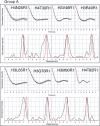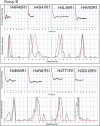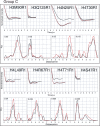Probing the (H3-H4)2 histone tetramer structure using pulsed EPR spectroscopy combined with site-directed spin labelling
- PMID: 19914933
- PMCID: PMC2810997
- DOI: 10.1093/nar/gkp1003
Probing the (H3-H4)2 histone tetramer structure using pulsed EPR spectroscopy combined with site-directed spin labelling
Abstract
The (H3-H4)(2) histone tetramer forms the central core of nucleosomes and, as such, plays a prominent role in assembly, disassembly and positioning of nucleosomes. Despite its fundamental role in chromatin, the tetramer has received little structural investigation. Here, through the use of pulsed electron-electron double resonance spectroscopy coupled with site-directed spin labelling, we survey the structure of the tetramer in solution. We find that tetramer is structurally more heterogeneous on its own than when sequestered in the octamer or nucleosome. In particular, while the central region including the H3-H3' interface retains a structure similar to that observed in nucleosomes, other regions such as the H3 alphaN helix display increased structural heterogeneity. Flexibility of the H3 alphaN helix in the free tetramer also illustrates the potential for post-translational modifications to alter the structure of this region and mediate interactions with histone chaperones. The approach described here promises to prove a powerful system for investigating the structure of additional assemblies of histones with other important factors in chromatin assembly/fluidity.
Figures






Similar articles
-
Structural basis for recognition of H3K56-acetylated histone H3-H4 by the chaperone Rtt106.Nature. 2012 Feb 5;483(7387):104-7. doi: 10.1038/nature10861. Nature. 2012. PMID: 22307274 Free PMC article.
-
The mouse mammary tumour virus promoter positioned on a tetramer of histones H3 and H4 binds nuclear factor 1 and OTF1.J Mol Biol. 1998 May 15;278(4):725-39. doi: 10.1006/jmbi.1998.1718. J Mol Biol. 1998. PMID: 9614938
-
Folding mechanism of the (H3-H4)2 histone tetramer of the core nucleosome.Protein Sci. 2004 May;13(5):1304-16. doi: 10.1110/ps.03535504. Protein Sci. 2004. PMID: 15096635 Free PMC article.
-
All roads lead to chromatin: multiple pathways for histone deposition.Biochim Biophys Acta. 2013 Mar-Apr;1819(3-4):238-46. Biochim Biophys Acta. 2013. PMID: 24459726 Review.
-
Histone chaperones: 30 years from isolation to elucidation of the mechanisms of nucleosome assembly and disassembly.Cell Mol Life Sci. 2008 Feb;65(3):414-44. doi: 10.1007/s00018-007-7305-6. Cell Mol Life Sci. 2008. PMID: 17955179 Free PMC article. Review.
Cited by
-
Getting down to the core of histone modifications.Chromosoma. 2014 Aug;123(4):355-71. doi: 10.1007/s00412-014-0465-x. Epub 2014 May 2. Chromosoma. 2014. PMID: 24789118 Review.
-
Structural basis for recognition of H3K56-acetylated histone H3-H4 by the chaperone Rtt106.Nature. 2012 Feb 5;483(7387):104-7. doi: 10.1038/nature10861. Nature. 2012. PMID: 22307274 Free PMC article.
-
Histone H2A/H2B dimer exchange by ATP-dependent chromatin remodeling activities.Mol Cell. 2003 Dec;12(6):1599-606. doi: 10.1016/s1097-2765(03)00499-4. Mol Cell. 2003. PMID: 14690611 Free PMC article.
-
Global structure of a three-way junction in a phi29 packaging RNA dimer determined using site-directed spin labeling.J Am Chem Soc. 2012 Feb 8;134(5):2644-52. doi: 10.1021/ja2093647. Epub 2012 Jan 27. J Am Chem Soc. 2012. PMID: 22229766 Free PMC article.
-
In vivo assembly of complete eukaryotic nucleosomes and (H3-H4)-only non-canonical nucleosomal particles in the model bacterium Escherichia coli.Commun Biol. 2024 Nov 14;7(1):1510. doi: 10.1038/s42003-024-07211-4. Commun Biol. 2024. PMID: 39543208 Free PMC article.
References
-
- Luger K, Rechsteiner TJ, Flaus AJ, Waye MM, Richmond TJ. Characterization of nucleosome core particles containing histone proteins made in bacteria. J. Mol. Biol. 1997;272:301–311. - PubMed
-
- Jorcano JL, Ruiz-Carrillo A. H3.H4 tetramer directs DNA and core histone octamer assembly in the nucleosome core particle. Biochemistry. 1979;18:768–774. - PubMed
-
- Polach KJ, Widom J. Mechanism of protein access to specific DNA-sequences in chromatin – a dynamic equilibrium-model for gene-regulation. J. Mol. Biol. 1995;254:130–149. - PubMed

